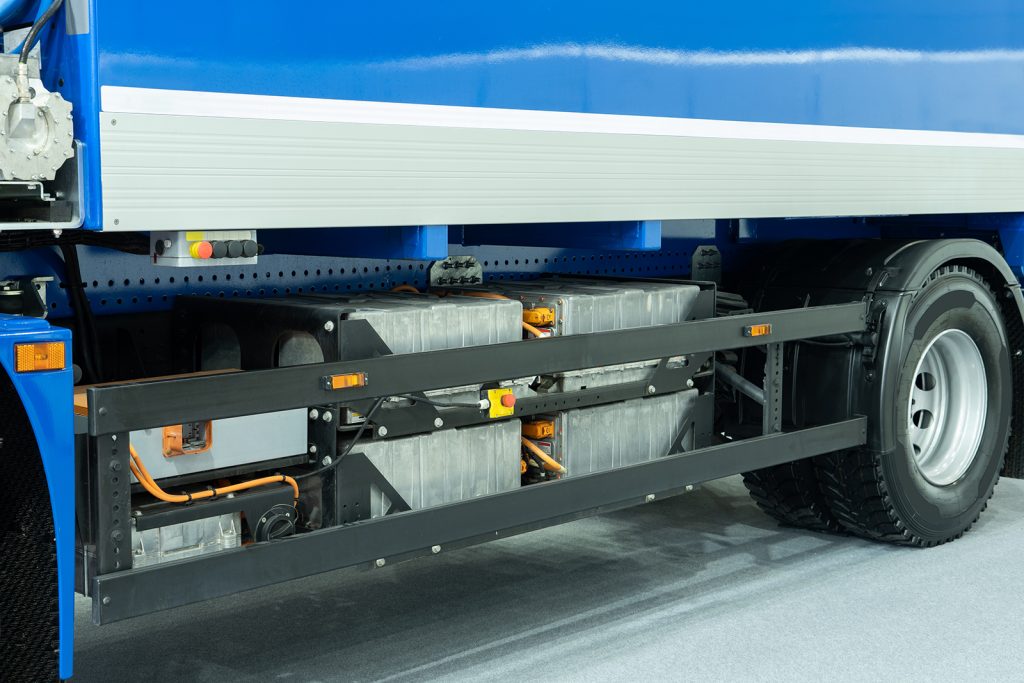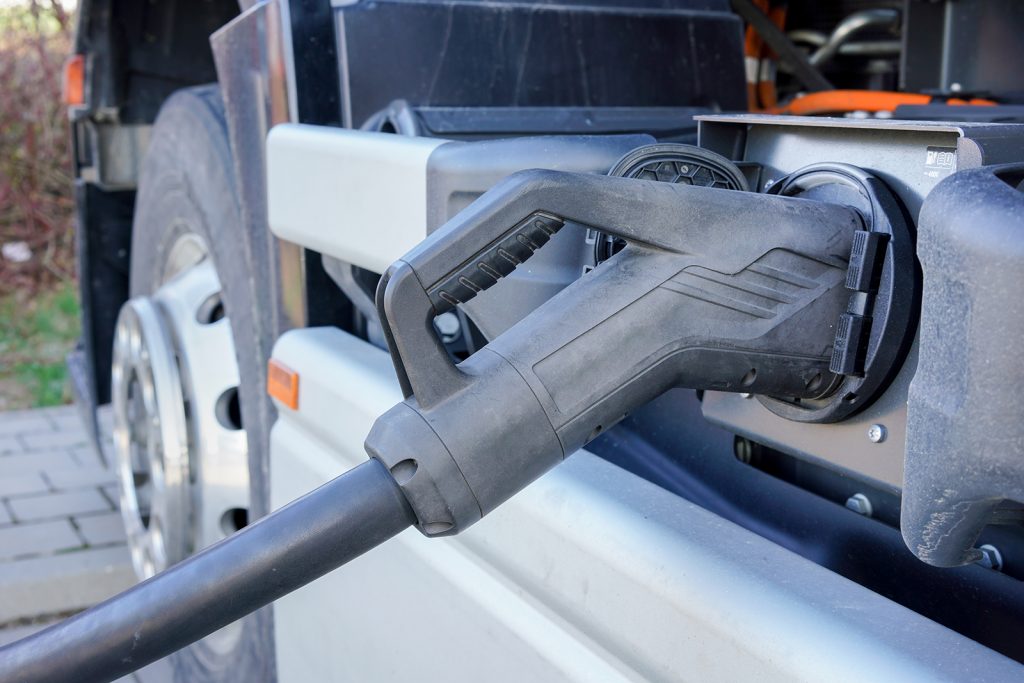This is what it takes to electrify the trucking sector
La extensión de una infraestructura de recarga más potente y las mejoras en la eficiencia de las baterías son los retos fundamentales de un proceso todavía en cifras marginales

El transporte de mercancías por carretera sigue el mismo camino de electrificación que los vehículos privados de transporte de personas, pero a un ritmo mucho más lento. Las marcas de camiones lanzan cada año novedades que tratan de animar un mercado todavía muy minoritario pero que, cada año, avanza imparable. La falta de infraestructuras de recarga y la baja autonomía de las baterías en comparación con los depósitos de diésel son los principales obstáculos de este proceso de electrificación que, según la normativa europea, debe contribuir de manera decisiva a reducir las emisiones un 45% en cinco años y un 90% en 2040.
En un mundo que avanza hacia la descarbonización, el transporte por carretera es uno de los sectores que está en el punto de mira por el peso de su aportación a la contaminación atmosférica y el cambio climático. Los estudios apuntan a que los gases que expulsan por los tubos de escape los vehículos de todo tipo destinados al transporte por carretera suponen una cuarta parte del total. De esta porción, más de un 70% procede de los camiones que mueven las mercancías y, por tanto, buena parte de las economías de los países.

Se triplican las ventas
Los camiones eléctricos son una de las alternativas para reducir la contaminación derivada del tráfico de mercancías. Pero, por el momento, las ventas de este tipo de vehículos suponen únicamente un pequeño porcentaje del total, unas cifras prácticamente residuales a escala global. En Europa, los últimos datos apuntan a que la cifra de camiones de gran tonelaje vendidos se triplica cada año, pero apenas alcanzaba el 1% del total a principios de 2024. El porcentaje se eleva al 5% en camiones ligeros y medios, de entre 3,5 y 12 toneladas. En España, según la Asociación Española de Fabricantes de Automóviles y Camiones (Anfac), solo el 0,6% de los camiones de más de 16 toneladas son eléctricos.
Otros territorios, como Estados Unidos, siguen el mismo patrón que Europa. Según datos del Environmental Defense Fund, de 12,2 millones de camiones en circulación, solo 13.000 son eléctricos, es decir, poco más del 0,1%. Esta cifra, además, incluye desde tractocamiones a furgonetas de categoría superior, un segmento que se adapta mejor a las necesidades de autonomía de los vehículos a batería porque se dedica a la última milla. Es decir, requieren de una menor autonomía para cumplir su función.
La cuestión es: ¿cómo ganar terreno en una competición en la que un camión diésel puede recorrer unas diez veces más distancia que uno eléctrico sin repostar? Con el añadido, además, de que los motores térmicos tienen un coste de la mitad o menos que los eléctricos. Y aún más, sabiendo que los márgenes en el transporte por carretera, según expertos del sector, son estrechos, del 2% como máximo. ¿Cómo rentabilizar una inversión en el camión eléctrico?
La respuesta es, a la vez, sencilla y complicada. En las condiciones actuales del mercado en cuanto a precios de los camiones, del combustible y la electricidad y de la extensión y la potencia de la red de puntos de recarga, no todos los negocios de transporte de mercancías por carretera pueden electrificarse. O no pueden hacerlo al mismo ritmo y con la misma intensidad.

Servicios de asesoramiento
Por eso, las propias marcas asesoran a empresas para llevar a cabo un proceso de electrificación realista y racional. Tanto en casos de empresas dedicadas a transportar mercancías desde centros logísticos a los pueblos, ciudades y otras industrias cercanas, la denominada última milla, como en negocios dedicados al transporte de largas distancias. Porque bien planificada, la electrificación del transporte de mercancías de gran tonelaje y a largas distancias es posible, aunque requiere de una extensión realista de los puntos de carga y de la potencia de los mismos, así como del planteamiento de las rutas y los tiempos de entrega.
La ecuación sobre rentabilidad, autonomía y dificultades para la recarga en la batalla diésel-eléctrico se complica si se es capaz de imaginar un futuro en el que las rutas se calculan por los kilómetros que puede recorrer cada tipo de camión cada 24 o 48 horas, teniendo en cuenta las paradas obligatorias que deben realizar los conductores, si pueden o no cargar las baterías en estas paradas y, sobre todo, si se mete en la batidora de los cálculos el coste de un combustible y otro. Mientras que el precio del diésel no ha dejado de aumentar en los últimos años, la electricidad se puede llegar a producir a coste cero en el caso de que la empresa en cuestión cuente con paneles solares suficientes para recargar su flota.

Otras ventajas del camión eléctrico

Es una cuestión básicamente de números, pero los camiones eléctricos aportan otras ventajas más allá de una hoja de Excel. Sí, en su funcionamiento reducen emisiones de gases de efecto invernadero a cero, pero también son silenciosos, lo que contribuye a una menor contaminación acústica tanto para el entorno como para el conductor, como ha quedado demostrado en las pruebas de conducción de los modelos más recientes. También, en referencia a la persona que lo maneja, ofrecen otras comodidades, como la ausencia de vibraciones derivadas del funcionamiento del motor, algo que se agradece cuando se pasa media vida en una cabina.
En un futuro ideal de camiones eléctricos, las rutas y sus respectivos descansos se pueden planificar en función de los puntos de recarga existentes en el camino del punto A al punto B. Para ello, se necesita un plan ambicioso de dotación de estos puntos que, además, en el caso de las baterías de los camiones, deben tener unas características concretas para poder cargarse en tiempos razonables.
Con su plan Power to the road, Alemania planea extender una red de puntos de carga rápida para camiones y dar así el salto definitivo a la electrificación o, por lo menos, avanzar de forma decisiva hacia la descarbonización total del sector del transporte de mercancías antes de 2045. El gobierno germano pretende crear una red de carga rápida fácil de usar para camiones a lo largo de las autopistas. Esto se hará al mismo tiempo que se amplía la red eléctrica del país para absorber más energía renovable. Se trata de un ejemplo de apuesta decidida para empezar a hacer realidad una electrificación que todavía está en pañales.
Escrribe: Guillem Sanchis